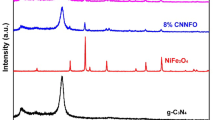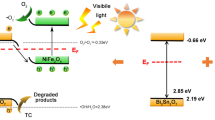Abstract
Semiconductor photocatalysts with suitable band gap for fair response to visible light and efficient separation of electron–hole pairs, are the key to practical application of photocatalytic technology. Magnetically separable hierarchical ZnFe2O4/g-C3N4 composite photocatalysts were prepared by a facile solvothermal method combined with a subsequent annealing process. The composite microspheres were composed of ZnFe2O4 nanoparticles, whose diameter was restricted due to the confined space effect from g-C3N4 nanosheets. ZnFe2O4/g-C3N4 heterojunction structures led to the improvement of the efficiency for photodegrading methylene blue and rhodamine B under visible light, where the kinetic constant over ZnFe2O4/CN-150 photocatalyst was more than ten times larger than that over pure ZnFe2O4. The photogenerated electrons from g-C3N4 surfaces could easily migrate to ZnFe2O4, leading to efficient separation of electron–hole pairs. Also, the composite photocatalyst possessed a chemical stability against photocorrosion and a magnetic property, which made it magnetically separable and reusable conveniently.
Graphical Abstract








Similar content being viewed by others
References
Li X, Yu J, Jaroniec M (2016) Hierarchical photocatalysts. Chem Soc Rev 45(9):2603–2636
Dong H, Zeng G, Tang L, Fan C, Zhang C, He X et al (2015) An overview on limitations of TiO2-based particles for photocatalytic degradation of organic pollutants and the corresponding countermeasures. Water Res 79:128–146
Mehrjouei M, Müller S, Möller D (2015) A review on photocatalytic ozonation used for the treatment of water and wastewater. Chem Eng J 263:209–219
Vaiano V, Sacco O, Sannino D, Ciambelli P (2015) Photocatalytic removal of spiramycin from wastewater under visible light with N-doped TiO2 photocatalysts. Chem Eng J 261:3–8
Trellu C, Mousset E, Pechaud Y, Huguenot D, van Hullebusch ED, Esposito G et al (2016) Removal of hydrophobic organic pollutants from soil washing/flushing solutions: a critical review. J Hazard Mater 306:149–174
Tang L, Wang J, Zeng G, Liu Y, Deng Y, Zhou Y et al (2016) Enhanced photocatalytic degradation of norfloxacin in aqueous Bi2WO6 dispersions containing nonionic surfactant under visible light irradiation. J Hazard Mater 306:295–304
Wang H, Yuan X, Wu Y, Zeng G, Chen X, Leng L et al (2015) Synthesis and applications of novel graphitic carbon nitride/metal-organic frameworks mesoporous photocatalyst for dyes removal. Appl Catal B 174–175:445–454
Liang Z, Wen Q, Wang X, Zhang F, Yu Y (2016) Chemically stable and reusable nano zero-valent iron/graphite-like carbon nitride nanohybrid for efficient photocatalytic treatment of Cr(VI) and rhodamine B under visible light. Appl Surf Sci 386:451–459
Marinho BA, Cristóvão RO, Djellabi R, Loureiro JM, Boaventura RAR, Vilar VJP (2017) Photocatalytic reduction of Cr(VI) over TiO2-coated cellulose acetate monolithic structures using solar light. Appl Catal B 203:18–30
Di J, Xia J, Ji M, Yin S, Li H, Xu H et al (2015) Controllable synthesis of Bi4O5Br2 ultrathin nanosheets for photocatalytic removal of ciprofloxacin and mechanism insight. J Mater Chem A 3(29):15108–15118
Sturini M, Speltini A, Maraschi F, Profumo A, Pretali L, Irastorza EA et al (2012) Photolytic and photocatalytic degradation of fluoroquinolones in untreated river water under natural sunlight. Appl Catal B 119–120:32–39
Wang C-C, Li J-R, Lv X-L, Zhang Y-Q, Guo G (2014) Photocatalytic organic pollutants degradation in metal–organic frameworks. Energy Environ Sci 7(9):2831
Li Y, Hou Y, Fu Q, Peng S, Hu YH (2017) Oriented growth of ZnIn2S4/In(OH)3 heterojunction by a facile hydrothermal transformation for efficient photocatalytic H2 production. Appl Catal B 206:726–733
Jin X, Ye L, Xie H, Chen G (2017) Bismuth-rich bismuth oxyhalides for environmental and energy photocatalysis. Coord Chem Rev 349:84–101
Sun L, Shao R, Tang L, Chen Z (2013) Synthesis of ZnFe2O4/ZnO nanocomposites immobilized on graphene with enhanced photocatalytic activity under solar light irradiation. J Alloys Compd 564:55–62
Wu S, Shen X, Zhu G, Zhou H, Ji Z, Chen K et al (2016) Synthesis of ternary Ag/ZnO/ZnFe2O4 porous and hollow nanostructures with enhanced photocatalytic activity. Appl Catal B 184:328–336
Wang M, Sun L, Cai J, Huang P, Su Y, Lin C (2013) A facile hydrothermal deposition of ZnFe2O4 nanoparticles on TiO2 nanotube arrays for enhanced visible light photocatalytic activity. J Mater Chem A 1(39):12082
Yao Y, Qin J, Chen H, Wei F, Liu X, Wang J et al (2015) One-pot approach for synthesis of N-doped TiO2/ZnFe2O4 hybrid as an efficient photocatalyst for degradation of aqueous organic pollutants. J Hazard Mater 291:28–37
Chen X, Dai Y, Liu T, Guo J, Wang X, Li F (2015) Magnetic core–shell carbon microspheres (CMSs)@ZnFe2O4/Ag3PO4 composite with enhanced photocatalytic activity and stability under visible light irradiation. J Mol Catal A 409:198–206
Kong L, Jiang Z, Xiao T, Lu L, Jones MO, Edwards PP (2011) Exceptional visible-light-driven photocatalytic activity over BiOBr–ZnFe2O4 heterojunctions. Chem Commun 47(19):5512
Yu TH, Cheng WY, Chao KJ, Lu SY (2013) ZnFe2O4 decorated CdS nanorods as a highly efficient, visible light responsive, photochemically stable, magnetically recyclable photocatalyst for hydrogen generation. Nanoscale 5(16):7356–7360
Niu P, Zhang LL, Liu G, Cheng HM (2012) Graphene-like carbon nitride nanosheets for improved photocatalytic activities. Adv Funct Mater 22(22):4763–4770
Xu J, Li Y, Peng S, Lu G, Li S (2013) Eosin Y-sensitized graphitic carbon nitride fabricated by heating urea for visible light photocatalytic hydrogen evolution: the effect of the pyrolysis temperature of urea. Phys Chem Chem Phys 15(20):7657–7665
He F, Chen G, Yu Y, Hao S, Zhou Y, Zheng Y (2014) Facile approach to synthesize g-PAN/g-C3N4 composites with enhanced photocatalytic H2 evolution activity. ACS Appl Mater Interfaces 6(10):7171–7179
Lu Z, Zeng L, Song W, Qin Z, Zeng D, Xie C (2017) In situ synthesis of C-TiO2/g-C3N4 heterojunction nanocomposite as highly visible light active photocatalyst originated from effective interfacial charge transfer. Appl Catal B 202:489–499
Xu H, Yan J, Xu Y, Song Y, Li H, Xia J et al (2013) Novel visible-light-driven AgX/graphite-like C3N4 (X = Br, I) hybrid materials with synergistic photocatalytic activity. Appl Catal B 129:182–193
Li M, Zhang L, Fan X, Zhou Y, Wu M, Shi J (2015) Highly selective CO2 photoreduction to CO over g-C3N4/Bi2WO6 composites under visible light. J Mater Chem A 3(9):5189–5196
Miao G, Huang D, Ren X, Li X, Li Z, Xiao J (2016) Visible-light induced photocatalytic oxidative desulfurization using BiVO4/C3N4@SiO2 with air/cumene hydroperoxide under ambient conditions. Appl Catal B 192:72–79
He F, Chen G, Miao J, Wang Z, Su D, Liu S et al (2016) Sulfur-mediated self-templating synthesis of tapered C-PAN/g-C3N4 composite nanotubes toward efficient photocatalytic H2 evolution. ACS Energy Lett 1(5):969–975
Zhang J, Wang Y, Jin J, Zhang J, Lin Z, Huang F et al (2013) Efficient visible-light photocatalytic hydrogen evolution and enhanced photostability of core/shell CdS/g-C3N4 nanowires. ACS Appl Mater Interfaces 5(20):10317–10324
Wang H, Zhang L, Chen Z, Hu J, Li S, Wang Z et al (2014) Semiconductor heterojunction photocatalysts: design, construction, and photocatalytic performances. Chem Soc Rev 43(15):5234–5244
Zhang S, Li J, Zeng M, Zhao G, Xu J, Hu W et al (2013) In situ synthesis of water-soluble magnetic graphitic carbon nitride photocatalyst and its synergistic catalytic performance. ACS Appl Mater Interfaces 5(23):12735–12743
Yao Y, Cai Y, Lu F, Qin J, Wei F, Xu C et al (2014) Magnetic ZnFe2O4–C3N4 hybrid for photocatalytic degradation of aqueous organic pollutants by visible light. Ind Eng Chem Res 53(44):17294–17302
Chen J, Shen SH, Guo PH, Wu P, Guo LJ (2014) Spatial engineering of photo-active sites on g-C3N4 for efficient solar hydrogen generation. J Mater Chem A 2(13):4605–4612
Zhang X, Xie X, Wang H, Zhang J, Pan B, Xie Y (2013) Enhanced photoresponsive ultrathin graphitic-phase C3N4 nanosheets for bioimaging. J Am Chem Soc 135(1):18–21
Lin Q, Li L, Liang S, Liu M, Bi J, Wu L (2015) Efficient synthesis of monolayer carbon nitride 2D nanosheet with tunable concentration and enhanced visible-light photocatalytic activities. Appl Catal B 163:135–142
Zhang C, Chen G, Li C, Sun J, Lv C, Fan S et al (2016) In situ fabrication of Bi2WO6/MoS2/RGO heterojunction with nanosized interfacial contact via confined space effect toward enhanced photocatalytic properties. ACS Sustain Chem Eng 4(11):5936–5942
Wang W, Liu Y, Qu J, Chen Y, Tadé MO, Shao Z (2017) Synthesis of hierarchical TiO2-C3N4 hybrid microspheres with enhanced photocatalytic and photovoltaic activities by maximizing the synergistic effect. ChemPhotoChem 1(1):35–45
Liu J, Zhang T, Wang Z, Dawson G, Chen W (2011) Simple pyrolysis of urea into graphitic carbon nitride with recyclable adsorption and photocatalytic activity. J Mater Chem 21(38):14398
Zhou X, Li X, Sun H, Sun P, Liang X, Liu F et al (2015) Nanosheet-assembled ZnFe2O4 hollow microspheres for high-sensitive acetone sensor. ACS Appl Mater Interfaces 7(28):15414–15421
Wang F, Wen Z, Shen C, Rui K, Wu X, Chen C (2015) Open mesoporous spherical shell structured Co3O4 with highly efficient catalytic performance in Li–O2 batteries. J Mater Chem A 3(14):7600–7606
Li J, Wang J, Wexler D, Shi D, Liang J, Liu H et al (2013) Simple synthesis of yolk-shelled ZnCo2O4 microspheres towards enhancing the electrochemical performance of lithium-ion batteries in conjunction with a sodium carboxymethyl cellulose binder. J Mater Chem A 1(48):15292
Di J, Xia J, Ji M, Wang B, Yin S, Zhang Q et al (2015) Carbon quantum dots modified BiOCl ultrathin nanosheets with enhanced molecular oxygen activation ability for broad spectrum photocatalytic properties and mechanism insight. ACS Appl Mater Interfaces 7(36):20111–20123
Li T, Zhao L, He Y, Cai J, Luo M, Lin J (2013) Synthesis of g-C3N4/SmVO4 composite photocatalyst with improved visible light photocatalytic activities in RhB degradation. Appl Catal B 129:255–263
Peeters D, Taffa DH, Kerrigan MM, Ney A, Jöns N, Rogalla D et al (2017) Photoactive zinc ferrites fabricated via conventional CVD approach. ACS Sustain Chem Eng 5(4):2917–2926
Meidanchi A, Akhavan O, Khoei S, Shokri AA, Hajikarimi Z, Khansari N (2015) ZnFe2O4 nanoparticles as radiosensitizers in radiotherapy of human prostate cancer cells. Mater Sci Eng C 46:394–399
Teh PF, Sharma Y, Pramana SS, Srinivasan M (2011) Nanoweb anodes composed of one-dimensional, high aspect ratio, size tunable electrospun ZnFe2O4 nanofibers for lithium ion batteries. J Mater Chem 21(38):14999
Hong J, Xia X, Wang Y, Xu R (2012) Mesoporous carbon nitride with in situ sulfur doping for enhanced photocatalytic hydrogen evolution from water under visible light. J Mater Chem 22(30):15006
Liu G, Niu P, Sun C, Smith SC, Chen Z, Lu GQ et al (2010) Unique electronic structure induced high photoreactivity of sulfur-doped graphitic C3N4. J Am Chem Soc 132(33):11642–11648
Baciocchi E, Del Giacco T, Elisei F, Gerini MF, Guerra M, Lapi A et al (2003) Electron transfer and singlet oxygen mechanisms in the photooxygenation of dibutyl sulfide and thioanisole in MeCN sensitized by N-methylquinolinium tetrafluoborate and 9,10-dicyanoanthracene. The probable involvement of a thiadioxirane intermediate in electron transfer photooxygenations. J Am Chem Soc 125(52):16444–16454
Hufnagel AG, Peters K, Müller A, Scheu C, Fattakhova-Rohlfing D, Bein T (2016) Zinc ferrite photoanode nanomorphologies with favorable kinetics for water-splitting. Adv Funct Mater 26(25):4435–4443
Acknowledgements
This work was financially supported by projects of National Natural Science Foundation of China (21403046).
Author information
Authors and Affiliations
Corresponding authors
Ethics declarations
Conflict of interest
The authors declare no competing financial interest.
Electronic supplementary material
Below is the link to the electronic supplementary material.
Rights and permissions
About this article
Cite this article
Wu, Y., Wang, Y., Di, A. et al. Enhanced Photocatalytic Performance of Hierarchical ZnFe2O4/g-C3N4 Heterojunction Composite Microspheres. Catal Lett 148, 2179–2189 (2018). https://doi.org/10.1007/s10562-018-2376-6
Received:
Accepted:
Published:
Issue Date:
DOI: https://doi.org/10.1007/s10562-018-2376-6




